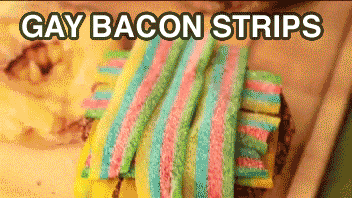 Bacon
BaconBacon is a cured meat prepared from a pig. It is first cured using large quantities of salt, either in a brine or in a dry packing; the result is fresh bacon (also known as green bacon). Fresh bacon may then be further dried for weeks or months in cold air, boiled, or smoked. Fresh and dried bacon must be cooked before eating. Boiled bacon is ready to eat, as is some smoked bacon, but may be cooked further before eating.
Curing and smoking baconBacon is cured through either a process of injecting with or soaking in brine or using plain salt (dry curing).In America, bacon is usually cured and smoked, and different flavors can be achieved by using various types of wood, or rarely corn cobs; peat is sometimes used in the UK. This process can take up to eighteen hours, depending on the intensity of the flavor desired. The Virginia House-Wife (1824), thought to be one of the earliest American cookbooks, gives no indication that bacon is ever not smoked, though it gives no advice on flavoring, noting only that care should be taken lest the fire get too hot.[6] In early American history, the preparation and smoking of bacon (like the making of sausage) seems to have been a gender-neutral process, one of the few food-preparation processes not divided by gender.[7]
In the United Kingdom and Ireland, smoked and unsmoked varieties are equally common, unsmoked being referred to as green bacon. The leaner cut of back bacon is preferred to the bacon from the belly (that is ubiquitous in the United States) which is referred to as streaky bacon due to the prominence of the bands of fat. While there is a tendency on both sides of the Atlantic to serve belly bacon well-done to crispy, back bacon may at first appear undercooked to Americans.
Around the worldTraditionally, the skin is left on the cut and is known as bacon rind, but rindless bacon is also common throughout the English-speaking world. The meat may be bought smoked or unsmoked. Bacon is often served with eggs as part of a full breakfast.
Australia and New Zealand
Generally as for the United Kingdom. Middle bacon is the most common variety and are sold in "rashers". Middle bacon includes the streaky, fatty section along with the loin at one end. In response to increasing consumer diet-consciousness, some supermarkets also offer the loin section only. This is sold as "short cut bacon" and is usually priced slightly higher than middle bacon. Both varieties are usually available in rindless, that is, with the rind removed.
An individual piece of bacon is a slice or strip. In Canada:
The term bacon on its own or, more specifically, side bacon typically refers to bacon from the pork belly.
Back bacon refers to either smoked or unsmoked bacon cut from the boneless eye of pork loin. Called Canadian bacon in the United States.
Peameal bacon is back bacon, brined and coated in fine cornmeal (historically, it was rolled in a meal made from ground dried peas).United States
A side of unsliced bacon was once known as a flitch it is now known as a slab. An individual slice of bacon is a slice or strip. The term rasher of bacon is occasionally encountered (e.g., on restaurant menus) to mean a serving of bacon (typically several slices).
American bacons include varieties smoked with hickory or corncobs and flavorings such as red pepper, molasses, and occasionally cinnamon. They vary in sweetness and saltiness and come from the Ozarks, New England and from the upper South (mainly Kentucky, North Carolina, Tennessee and Virginia).
The term bacon on its own refers generically to strip bacon from the belly meat of the pig, which is the most popular type of bacon sold in the U.S.
The term Canadian Bacon or Canadian-style bacon must be made from the pork loin, and means back bacon, but this term refers usually to the lean ovoid portion (longissimus muscle, or loineye). It also can be made from the sirloin portion of the loin (gluteal muscles), but must be labeled appropriately. Similar products made from the ham are used as less expensive substitutes.
Bacon Stories/How you cook Bacon/picture of bacon and such.My dad makes homemade bacon every summer.
It's not the typical bacon you get from the store, it's really thing, and it's only about 2 inches long per piece. However, it's so damned good, I just eat it raw, then chew on the rind after.
<3

bacon strips &
bacon strips &
bacon strips &
bacon strips &
bacon strips &
bacon strips &

gay bacon strips

that bacon was the best bacon I had ever had by the way.